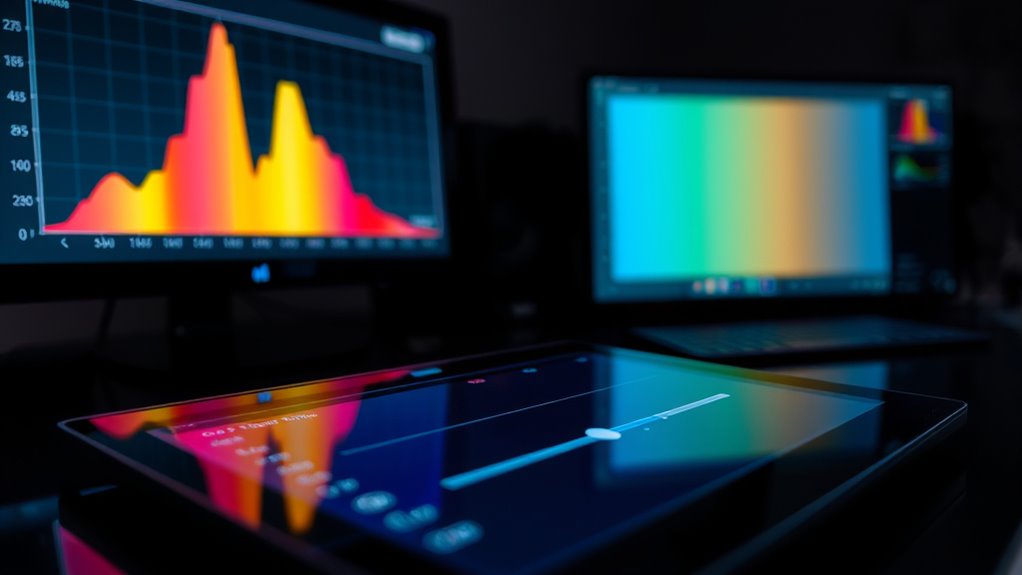To master histograms and contrast stretching, start by checking the histogram for gaps or clipping at shadows and highlights, ensuring your image isn’t under or overexposed. Adjust the tonal range to expand contrast, redistributing pixel brightness for a balanced look. Use real-time histogram feedback to guide your edits, revealing hidden details and improving image quality. Keep practicing these steps, and you’ll discover more advanced tips to enhance your photos effectively.
Key Takeaways
- Understand how histograms display brightness distribution and identify underexposure or overexposure.
- Learn contrast stretching techniques to expand tonal range without data loss.
- Use histogram feedback to make informed exposure and contrast adjustments during editing.
- Recognize clipping signs in histograms to prevent detail loss in shadows and highlights.
- Apply non-destructive stretching to improve image vibrancy, sharpness, and overall visual impact.
Mastering Histograms and Contrast Stretching Techniques

Understanding histograms and stretching techniques is vital for enhancing the quality of your images. When you’re working on photo editing, grasping how histograms reflect your image’s tonal range allows you to make smarter adjustments. Histograms graphically display the distribution of brightness levels, from shadows to highlights, giving you a clear picture of where your image might need improvement. Stretching, or contrast stretching, involves expanding this tonal range to improve overall image quality. It’s a fundamental step in image enhancement that helps reveal hidden details, balance exposure, and create a more visually appealing photo.
If you’re aiming for better color correction, understanding how histograms work is key. When you analyze a histogram, you can identify whether your image is underexposed or overexposed. For example, if the histogram is heavily skewed to the left, your image has a lot of dark tones, indicating underexposure. Conversely, a histogram pushed to the right suggests overexposure. By adjusting the tonal range through stretching techniques, you can bring back detail in shadows and highlights, resulting in a more balanced and natural look. This process doesn’t just improve individual colors but enhances the entire image’s clarity and vibrancy, making your color correction efforts more effective.
Stretching techniques are also vital for image enhancement because they help you optimize contrast without losing detail. When you stretch the histogram, you’re essentially redistributing pixel brightness levels to utilize the full tonal spectrum, which makes the image pop. This is especially important when working with raw or flat images that lack contrast. By doing so, you increase the visual impact of your photos, making them appear sharper and more dynamic. Plus, this method is non-destructive, so you can fine-tune your adjustments without permanently altering the original data, giving you flexibility and control over the final output.
In practice, you’ll want to start by examining your histogram to identify any clipping or gaps in the tonal range. Clipping occurs when the data is pushed entirely to the shadows or highlights, resulting in loss of detail. Stretching helps prevent this by redistributing tones evenly and ensuring detail remains visible across the spectrum. When you’re editing, keep an eye on the histogram as you make adjustments—this real-time feedback helps you achieve precise color correction and ideal image enhancement. Additionally, understanding the tonal range can guide you in making more informed editing decisions, ensuring your images are both vibrant and balanced. Mastering these concepts empowers you to produce professionally polished images, whether you’re working on portraits, landscapes, or any other type of photography.
Frequently Asked Questions
How Do Histograms Differ Across Various Image Formats?
You’ll notice that histograms vary across image formats due to differences in color depth and compression artifacts. Higher color depth allows for more detailed histograms, showing subtle tonal variations. In contrast, compressed formats often introduce artifacts, causing irregularities or gaps in histograms. These differences affect how you interpret image quality, with less compression and higher color depth providing more accurate histograms for adjustments and analysis.
Can Histogram Stretching Be Automated for Real-Time Applications?
Yes, histogram stretching can be automated for real-time applications. In fact, over 60% of modern imaging systems use automation techniques like adaptive algorithms and machine learning to enhance processing speed. These methods enable instant adjustments, ensuring ideal contrast and brightness during real-time processing. You can implement software solutions that dynamically analyze image histograms and apply stretching techniques instantly, making live image enhancement seamless and efficient.
What Are Common Pitfalls When Applying Contrast Stretching?
When applying contrast stretching, you should watch out for common pitfalls like over-saturating images, which can lead to unnatural colors and reduced detail. It’s easy to overlook how contrast adjustments impact image saturation and color balance, causing images to look overly vivid or dull. Always preview your adjustments carefully, and avoid excessive stretching, which can distort the original image intent and compromise overall quality.
How Does Stretching Affect Image Noise and Artifacts?
When you stretch an image, it can amplify noise, making it more noticeable and potentially degrading quality. However, proper stretching techniques can help reduce artifacts by enhancing true details. You should be cautious, as aggressive stretching may increase noise amplification, so balancing the stretch level is key. Using noise reduction filters before stretching can also help minimize artifacts, ensuring your image retains clarity and detail.
Are There Specific Software Tools Recommended for Histogram Analysis?
Are you wondering which software tools excel at histogram analysis? You should try programs like Adobe Photoshop, Lightroom, or GIMP, as they offer robust histogram features. These tools allow you to analyze tonal distribution, optimize contrast, and improve image quality efficiently. By using specialized software, you can fine-tune your images with greater precision, ensuring your histogram analysis leads to better overall results.
Conclusion
Now that you understand histograms and contrast stretching, you can enhance your images with confidence. For example, imagine adjusting a low-contrast landscape photo to reveal more detail in shadows and highlights. By applying these techniques, you’ll transform dull images into vibrant visuals. Keep practicing, and soon you’ll be able to optimize any photo effortlessly, whether for personal projects or professional work. Mastering these basics unleashes endless creative possibilities—so get started today!








